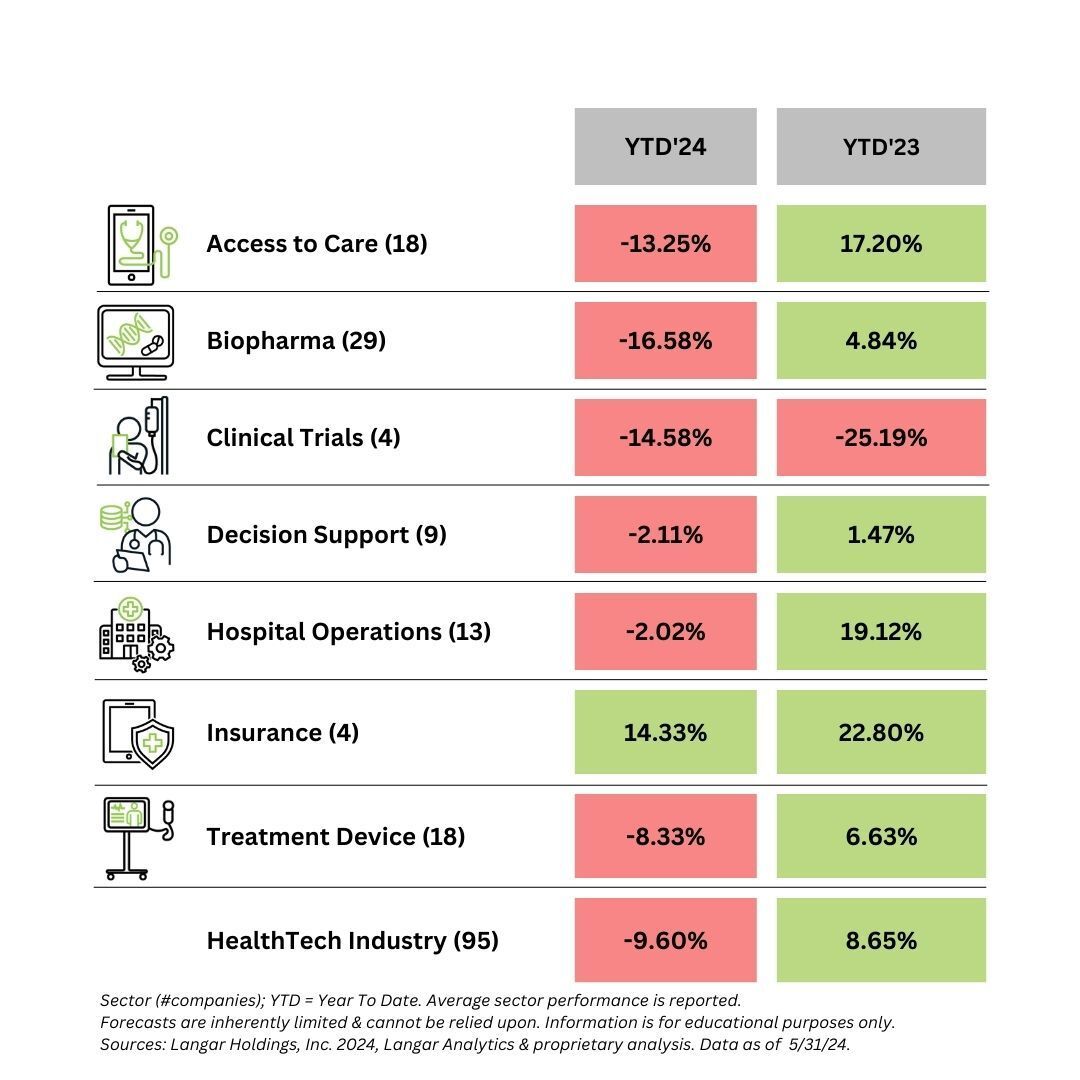- Market HighLiGHTs
- Posts
- Seeing Beyond the Human Eye
Seeing Beyond the Human Eye
AI in Radiology
AI has grown within healthcare, with the latest list of FDA approved medical devices illustrating same. Of that list, the field of radiology had the most AI/ML supported devices approved.
Here are some thoughts on the subject.
Accurately evaluating AI systems is the critical first step toward generating radiology reports that are clinically useful and trustworthy
Public Market Update: Average Sector Performance

Let’s first take a look at the HealthTech market.
HealthTech is getting slammed (friendly reminder: these values reflect the entire HealthTech industry, not Langar’s HealthTech ETF). Despite the apparent gloom, some of the subsectors, i.e. 🏥 Hospital Operations and 📋️ Decision Support, are slowly climbing out of their negative hole (reference last month’s newsletter for comparison).
A couple of subsectors worth discussing:
🖥️Access to Care companies, such as those engaged in telehealth, may be reeling from the recent expiration of government subsidies for internet access. During the pandemic, internet access was expanded and made more affordable for those in need so that they could remotely access care; that is now over as the funds have run out and Congress hasn’t figured out a solution.
💊 Biopharma companies that are NOT producing new drugs at the speed of light are also taking a hit. Of course there’s Moderna who has recently touted a Covid/Flu vaccine combo thats coming soon to a CVS pharmacy near you; but with the bulk of companies lagging in production, subsector performance has dropped.
With all the 🤖 AI buzz, it’s worth mentioning that smaller niche companies that use AI technology may struggle in the coming months to compete with the bigwigs. A prime example: as Epic systems develop and expand their own AI software, they’ll likely put the little guys out of business simply because Epic has such a strong market presence and will be difficult to compete with.
Of course, we can ruminate on the market until the end of time and still be surprised by what actually happens.
Learn more about each sector by clicking here: |
Articles Worth Reading
Beyond the Human Eye: The Emergence of AI in Radiology

Radiology was the clear winner in the latest list of FDA approved medical devices that are supported by AI/ML, garnering 671 successes out of the list of 882 devices.
Radiology is an obvious one to utilize AI as the field is driven by technology and imaging, and with the improved capabilities we now have to store data, allows for easy machine learning.
Ways in which AI could assist within the field:
📉 Triaging critical cases from noncritical, facilitating quicker read times for physicians.
📄 Pull historical patient medical information stored in EMR to assist with providing radiologists with context while reading images.
👨⚕️ Assist with improving accuracy when interpreting imaging studies and reducing error & discrepancies.
As AI in radiology grows, it will be imperative to ensure that outputs are reviewed to avoid mistakes. Over or under-interpreting findings can lead to unnecessary or delayed interventions, respectively.
Some of the excitement around AI expansion in this field is the hope to provide access to care for those in need. Billions of patients around the world lack access to basic radiology services, with 25% of low income countries wanting for basic cancer diagnostic services as well.
With so many devices on the horizon, it will be interesting to see how AI reshapes the field.
Opinion
A Doctor’s Perspective

There’s a real concern about the use of AI in healthcare. First, no one wants their jobs to be taken away, and another, the risk of mistakes and misinformation is, as of yet, high.
While approval for AI supported devices is great, there also needs to be strong regulation of its usage.
As we mentioned in our article about AI and liability, the question is: if a mistake is made when using an AI enhanced device, who is responsible? It’s a gray area that is cause for considerable concern, and understandably. Until AI can prove to be low risk, have consistently fewer mistakes, and I’d even argue improve outcomes, we must proceed cautiously.
As it stands today, physicians must still review and confirm or deny machine based information. I think going forward this should remain, no matter now sophisticated the technology. AI can’t yet replace human instincts or have or sense the real feelings of a person. Those things matter and often can make or break a patient’s care journey.
In the case of radiology, a radiologist may not see patients directly but they do rely on the information gathered by primary care physicians and emergency room doctors to provide context for imaging.
Healthcare needs help and HealthTech is a strong avenue to lead us to becoming more efficient. But healthcare also is an art; to provide the best care includes understanding that patients, and the human body, don’t always follow rules and textbooks.
The nuance is in the details and, I believe, humans are the best source to understand those details…and going forward, they can do so with the assistance of AI.
—Sanjana Vig MD,MBA (Anesthesiologist)
In the News
Interesting Articles From Around the Web
To round out the newsletter, here are some other interesting happenings in HealthTech.
❣️ HealthTech can reduce the risk of heart disease, study shows.
👵 Aging in place, a trend that may expedite bringing healthcare (and HealthTech) into the home.
⌚️ Wearables are projected to be a $70B market by 2028.
🌎️ World Health Organization launched S.A.R.A.H a smart AI assistant (not for medical advice).